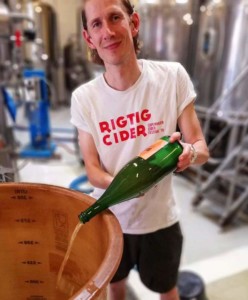Aeblerov

Morten Sylvest-Noer
About
Owner & winemaker: Morten Sylvest-Noer
Fruit sourcing: 100% purchased fruit
Farming practices: 90% organic and biodynamic fruit
Types of fruit: Apples (Rød Aroma, Holsteiner Cox, Topaz, Pigeon, Alkmene, Discovery), pears (Conference, Anna, Herrepære), and many others
Annual production: 50-60,000 bottles
Quick facts:
- Aeblerov makes ciders inspired by natural wine: nothing added, nothing removed, and a focus on the expression of pure fruit character.
- The production space is housed at To Øl, one of Denmark’s most highly regarded microbreweries.
- “Our philosophy is clearly to continue to create simple, delicate, pure ciders that focus exclusively on the apple varieties, but also to create experiences that inspire others and challenge their general perception of cider.” – Morten Sylvest-Noer
Growing apples has always been important in Denmark, but cider-making–not so much. Morten Sylvest-Noer, who founded Aeblerov in 2011, had the idea of changing that. It was initially a hobby project, using fruit from private gardens, but as he began using different varieties of apples, particularly eating apples, he was excited by the potential to make a new type of cider not seen before in Denmark, focused on showing the potential of the different varieties.
The Aeblerov ciders are a world away from the “alcopop” ciders mass-produced by the big breweries, but also totally distinct from more classic French and English styles. Their primary focus is on pure cider made from apples and pear, but they’ve been experimenting by adding grapes, quince, and berries as well. “With these new fruits, we can create new taste experiences that are close to the world of wine,” Morten explains. Sour apples in particular thrive in Denmark’s cold climate, leading to fruit with marked aromatic complexity.
The production style is inspired by natural wine: nothing added, nothing removed. No yeast or sulfur is added, and the bottle fermentation takes place with the natural sugars (i.e., méthode ancestrale). Some cuvées are disgorged, while others are released with their natural lees. As Morten puts it, “the idea is that minimal impact gives nature the best opportunity to unfold and thereby the most natural flavors.”
At the same time, sharing a production space with a microbrewery means they take inspiration from the beer world as well, particularly in its openness to experimentation. “We try to push the boundaries of cider, wine and beer by mixing the different categories together where it makes sense,” Morten explains–whether that means co-fermentations of apples and wine grapes, or exploring the potential of cider-beer hybrids.

